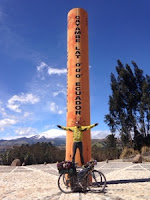 |
| The equator! |
Ecuador is one of our favorite countries, and with diverse rainforest, soaring mountains, and tropical coastline, it just might become your favorite, too. For the most part, the people were friendly and the food was great, with a variety of healthful food always available. Road choice is as diverse as the geography, with ample opportunities for on and off road riding. But be warned: if you´re planning on leaving the pavement, bring small gears and a mountain setup for frequently steep, cobbled roads. Ecuador ama la vida!
Click here for all our blog posts from our time biking, backpacking, and bikepacking in Ecuador.
 |
| Lagunas de Atillo, Sangay National Park |
We entered Quito the quiet back way - see here for details - and left on the massive highway to Sangolqui. The ascent to Cotopaxi was cobbled and rough, but biking in the park was fantastic and leads you straight out on a partly paved route to Lasso, the beginning of the Quilotoa Loop. The road from there to Sigchos is paved (at least the part of it we rode was) and moderately quiet. We diverged south to Isinlivi, ascending a scenic 4,000 meter pass before finding an adventurous back route to Chugchilan. From Chugchilan to Quilotoa is paved, though the last few kilometers of the climb are steep, sustained, and boring. The lake, however, is mind-blowing.
 |
| Quilotoa |
 |
| Approaching Cotopaxi |
Ecuador has three zones: the coast, the Sierra, and the Oriente. The Pan-Am stays in the cool mountains and has a lot of space for cyclists, the coast is hot and flat, and the Oriente is humid and hilly. Thus, the vast majority of cyclists stay in the Sierra, either on the Pan-Am or on the many mountain options off the main artery.
We were able to visit the Galapagos during our time in Ecuador and highly recommmend it! Everything is over-the-top expensive, but if you have some room in your budget (or even if not...) these islands are definitely worth a visit. Although there are a few roads you can bike, the only way to really get around is by boat.
Food
Good news: Ecuadorian bread has much less sugar than its Colombian counterpart. Every town, no matter how small, has a bakery or two, with rolls costing about 15 cents each. Cheese, fruits and veggies, and our favorite biking snack, banana chips (chifles), are available in essentially every small town as well.
Water
With our SteriPen working, we obtained and purified water from restaurants, houses, rivers, and hotels. Streams are abundant almost everywhere in the mountains, especially on the east side. I can't remember a single time in Ecuador when we carried more than our usual two liters of water each.
Shelter
Ecuador has many protected natural areas, and we felt comfortable wild camping in and near National Parks and ecological reserves. In rural areas with people around, which is most unprotected areas below 4,000 meters of elevation, we were able to camp in small town squares or in people's yards. In cities, we slept on a number of fire station floors and met some wonderful people through warmshowers. The policia is also an option in small towns; a few times we set up our tent right outside the station. We stayed in hotels a few times, paying from $10-$15 for the night.
We've heard rumors that some fire stations along the Pan-Am are no longer hosting cyclists. It would be a shame to see the rest of Ecuador follow suit. These may be nothing more than rumors, but remember when you stay with the bomberos to be respectful and clean.
 |
| Blue-footed Booby |
The Basics: Food, Water, and Shelter
Food
 |
| Cevichocho, our favorite street food. |
To our great joy, we also managed to find peanut butter. Look for mani molido (ground peanuts) or bags of pasta de mani in the condiment area of supermarkets. The packages recommend it to add to catfish soup, among other things. We ignored their advice and made PB&Js.
Sample Menu
Breakfast: PB&J sandwiches
Lunch: sandwiches with cheese, avocado and tomato.
Dinner: Couscous or ramen-style noodles (found everywhere) with olive oil, seasonings, chia seeds, nuts, veggies and sometimes beans from a can,
Water
With our SteriPen working, we obtained and purified water from restaurants, houses, rivers, and hotels. Streams are abundant almost everywhere in the mountains, especially on the east side. I can't remember a single time in Ecuador when we carried more than our usual two liters of water each.
Shelter
Ecuador has many protected natural areas, and we felt comfortable wild camping in and near National Parks and ecological reserves. In rural areas with people around, which is most unprotected areas below 4,000 meters of elevation, we were able to camp in small town squares or in people's yards. In cities, we slept on a number of fire station floors and met some wonderful people through warmshowers. The policia is also an option in small towns; a few times we set up our tent right outside the station. We stayed in hotels a few times, paying from $10-$15 for the night.
We've heard rumors that some fire stations along the Pan-Am are no longer hosting cyclists. It would be a shame to see the rest of Ecuador follow suit. These may be nothing more than rumors, but remember when you stay with the bomberos to be respectful and clean.

No comments:
Post a Comment